 | © 2001-2024 ./) . . ./) . . |
Great choice! Your favorites are temporarily saved for this session. Sign in to save them permanently, access them on any device, and receive relevant alerts.  Thistle is a 16 ′ 11 ″ / 5.2 m monohull sailboat designed by Gordon K. (Sandy) Douglass and built by Schock W.D., Douglass & McLeod, and Clark Boat Company starting in 1945.  Rig and SailsAuxilary power, accomodations, calculations. The theoretical maximum speed that a displacement hull can move efficiently through the water is determined by it's waterline length and displacement. It may be unable to reach this speed if the boat is underpowered or heavily loaded, though it may exceed this speed given enough power. Read more. Classic hull speed formula: Hull Speed = 1.34 x √LWL Max Speed/Length ratio = 8.26 ÷ Displacement/Length ratio .311 Hull Speed = Max Speed/Length ratio x √LWL Sail Area / Displacement RatioA measure of the power of the sails relative to the weight of the boat. The higher the number, the higher the performance, but the harder the boat will be to handle. This ratio is a "non-dimensional" value that facilitates comparisons between boats of different types and sizes. Read more. SA/D = SA ÷ (D ÷ 64) 2/3 - SA : Sail area in square feet, derived by adding the mainsail area to 100% of the foretriangle area (the lateral area above the deck between the mast and the forestay).
- D : Displacement in pounds.
Ballast / Displacement RatioA measure of the stability of a boat's hull that suggests how well a monohull will stand up to its sails. The ballast displacement ratio indicates how much of the weight of a boat is placed for maximum stability against capsizing and is an indicator of stiffness and resistance to capsize. Ballast / Displacement * 100 Displacement / Length RatioA measure of the weight of the boat relative to it's length at the waterline. The higher a boat’s D/L ratio, the more easily it will carry a load and the more comfortable its motion will be. The lower a boat's ratio is, the less power it takes to drive the boat to its nominal hull speed or beyond. Read more. D/L = (D ÷ 2240) ÷ (0.01 x LWL)³ - D: Displacement of the boat in pounds.
- LWL: Waterline length in feet
Comfort RatioThis ratio assess how quickly and abruptly a boat’s hull reacts to waves in a significant seaway, these being the elements of a boat’s motion most likely to cause seasickness. Read more. Comfort ratio = D ÷ (.65 x (.7 LWL + .3 LOA) x Beam 1.33 ) - D: Displacement of the boat in pounds
- LOA: Length overall in feet
- Beam: Width of boat at the widest point in feet
Capsize Screening FormulaThis formula attempts to indicate whether a given boat might be too wide and light to readily right itself after being overturned in extreme conditions. Read more. CSV = Beam ÷ ³√(D / 64) Spin area: 220 sq ft. Other builders: Northwest One Design Great Midwest Yacht Company Doug Laber Box 364 140 E Granville Street Sunbury, OH 43074 740-965-4511 Embed this page on your own website by copying and pasting this code. ©2024 Sea Time Tech, LLC This site is protected by reCAPTCHA and the Google Privacy Policy and Terms of Service apply. The Thistle 31 is a 31.08ft cutter designed by William Atkin and built in fiberglass since 1934.The Thistle 31 is a very heavy sailboat which is under powered. It is stable / stiff and has an excellent righting capability if capsized. It is best suited as a heavy bluewater cruising boat. 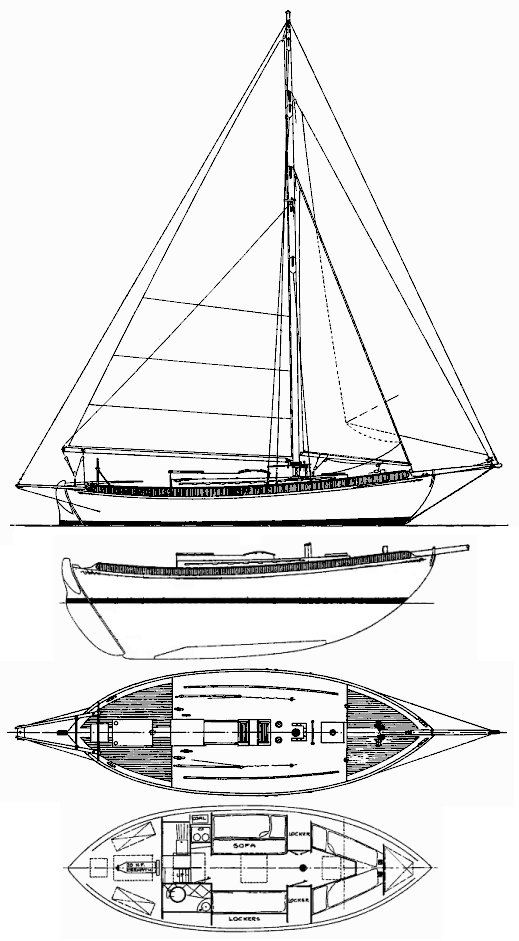 Thistle 31 for sale elsewhere on the web: Main features | Model | Thistle 31 | | | | Length | 31.08 ft | | | | Beam | 11 ft | | | | Draft | 5 ft | | | | Country | | | ?? | | Estimated price | $ 0 | | ?? | Login or register to personnalize this screen. You will be able to pin external links of your choice.  See how Sailboatlab works in video | Sail area / displ. | 13.52 | | | | Ballast / displ. | 0 % | | | | Displ. / length | 429.32 | | | | Comfort ratio | 44.37 | | | | Capsize | 1.62 | | | | Hull type | Monohull long keel with transom hung rudder | | | | Construction | Fiberglass | | | | Waterline length | 27.50 ft | | | | Maximum draft | 5 ft | | | | Displacement | 20000 lbs | | | | Ballast | 0 lbs | | | | Hull speed | 7.03 knots | | |  We help you build your own hydraulic steering system - Lecomble & Schmitt | Rigging | Cutter | | | | Sail area (100%) | 620 sq.ft | | | | Air draft | 0 ft | | ?? | | Sail area fore | 0 sq.ft | | ?? | | Sail area main | 0 sq.ft | | ?? | | I | 0 ft | | ?? | | J | 0 ft | | ?? | | P | 0 ft | | ?? | | E | 0 ft | | ?? | | Nb engines | 1 | | | | Total power | 0 HP | | | | Fuel capacity | 0 gals | | | Accommodations | Water capacity | 0 gals | | | | Headroom | 0 ft | | | | Nb of cabins | 0 | | | | Nb of berths | 0 | | | | Nb heads | 0 | | | Builder data | Builder | | | ?? | | Designer | William Atkin | | | | First built | 1934 | | | | Last built | 0 | | ?? | | Number built | 0 | | ?? | Modal TitleThe content of your modal. Personalize your sailboat data sheet Paste a link here: Give it a title: And eventually a link to an image for the thumbnail: A password will be e-mailed to you Reset Password  More informationImage gallery, floor plans. 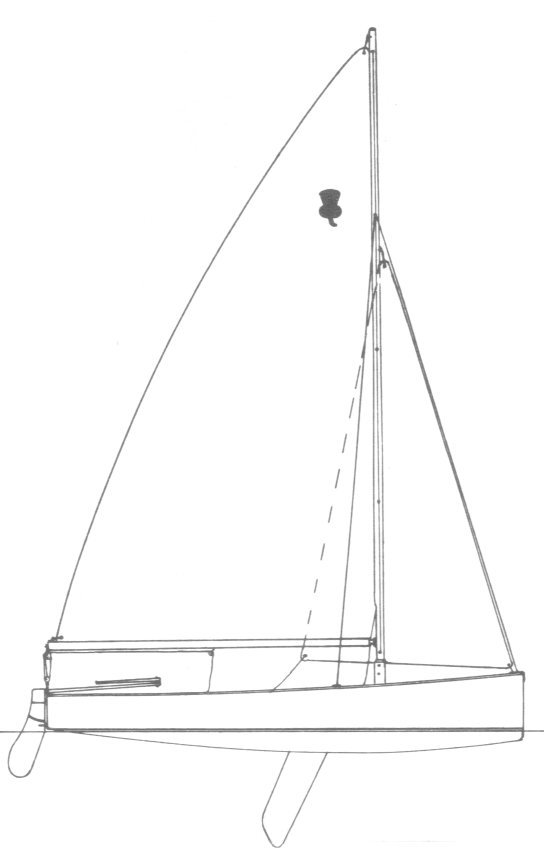 Use the form below to contact us!  Published on July 27th, 2021 | by Assoc Editor Thistle Class: celebrating 75 yearsPublished on July 27th, 2021 by Assoc Editor --> More than 100 three-person teams will descend on the Cleveland Yachting Club in Rocky River, Ohio to compete for the 75th Thistle National Championship, taking place July 31 to August 6, 2021. Situated on an island at the mouth of the Rocky River, eight miles west of downtown Cleveland, CYC is home to Thistle Fleet No. 1 and last hosted Thistle Nationals in 1995 for the class’s 50th anniversary. Racing begins this Saturday, July 31, as the Junior Nationals (20 and under) and Women’s Nationals get the party started with one-day series to determine their respective champions. On Sunday, August 1, the standard practice race for the Thistle National Championship gets an upgrade. This year, it serves as the 75th Anniversary Race, with all boats starting on one line. It’s bound to be an unforgettable sight for racers and spectators, alike. Opening ceremonies on Sunday night will officially kick the regatta off, with nightly parties on the island to follow all week long. The seven-race series for the Thistle National Championship officially begins on Monday, August 2. The large fleet will be split into four divisions for a three-race round-robin qualifying series over the first two days, after which a cut will be made to determine the Championship Fleet and President’s fleets.  Boats in the Championship fleet will retain their scores from the first two days and race for the National Championship, while boats in the President’s Fleet will start fresh on Wednesday and sail a four-race series of their own through Friday, August 6. The Nationals races typically follow “triangle-windward-leeward” courses, with each leg approximately one nautical mile in length. In a first for the Thistle class, boats in the Championship Fleet will be outfitted with GPS trackers, allowing spectators to follow the competition live via TracTrac. In addition to live race tracking, Tim Wilkes will be providing daily photos and videos. The 2021 Thistle National Championship is the culmination of the class’s summer circuit. Forty boats from 11 different states competed in the Thistle Great Lakes Championship at North Cape Yacht Club in LaSalle, Michigan two weeks ago. Similar regattas also took place for the Pacific Coast Championship, Atlantic Coast Championship, and Southeastern Championship. This year’s Great Lakes Championship served as a feeder event for those looking for some Lake Erie sailing before the Nationals, with many of those boats dry docked at CYC in the time since, patiently waiting for measurement and weigh-in to begin on Friday, July 30. After a year-long pandemic delay—the 75th Nationals were originally scheduled for 2020—the Thistle Class is eager to celebrate its 75th anniversary. The prospect of a full week of racing on the class’ home waters has attracted a large and talented fleet, which is sure to make for one of best Thistle Nationals yet. Follow the action at ThistleNationals2021.com Source: Mike Lovett, event media  Tags: Thistle , Thistle National Championship Related Posts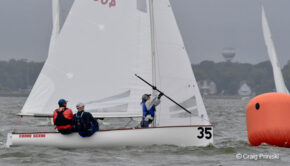 Thistle National Championship →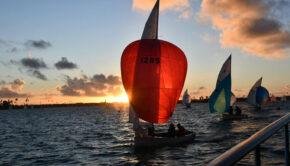 2024 Thistle Midwinters West →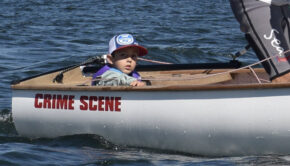 PHOTOS: No babysitter needed → 2023 Thistle US National Championship →© 2024 Scuttlebutt Sailing News. Inbox Communications, Inc. All Rights Reserved. made by VSSL Agency . - Privacy Statement
- Advertise With Us
Get Your Sailing News Fix!Your download by email. - Your Name...
- Your Email... *
- Phone This field is for validation purposes and should be left unchanged.
 - AROUND THE SAILING WORLD
- BOAT OF THE YEAR
- Email Newsletters
- America’s Cup
- St. Petersburg
- Caribbean Championship
- Boating Safety
- Ultimate Boating Giveaway
 One-Design Showcase About the ThistleThe Thistle is a high performance one design racing sailboat that is generally sailed with a three person crew. The Thistle Class Association is recognized as one of the largest and best one-design classes in the country. Thistle fleets are located throughout the US and welcome new and experienced sailors. Fleet members are happy to take new Thistle sailors out sailing and help get new boat owners up to speed. Joining a fleet and crewing is an excellent way to get started in the Thistle. Instructional DVD’s also help sailors get up to speed. 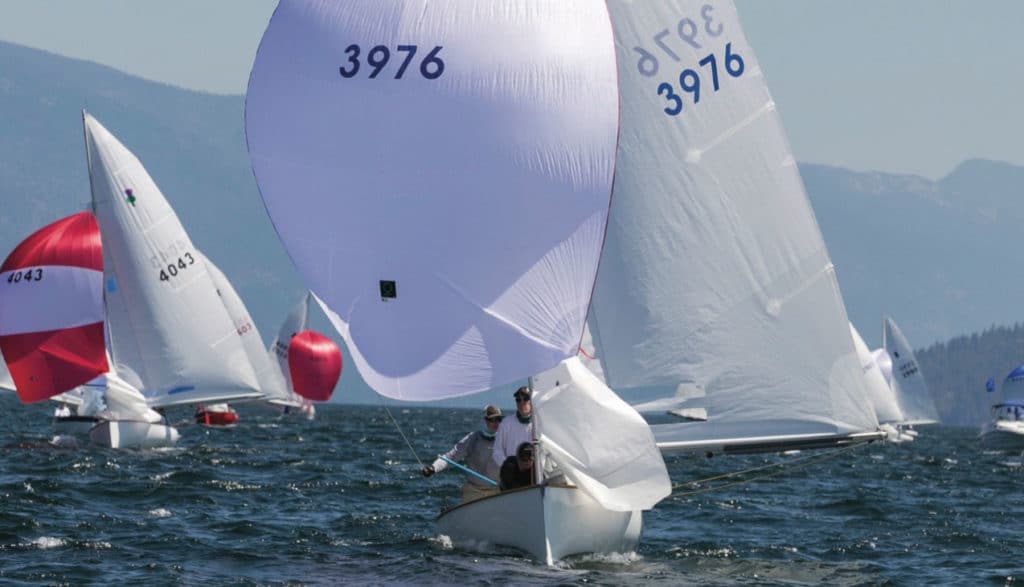 The TCA publishes a top-notch magazine, the Bagpipe, which not only reports on all the class news, but often includes rigging and go-fast tips. The class culture makes this Thistle unique. The competitive design and caliber of sailors attracts top sailors. The class also enjoys family camaraderie and often teams are comprised of family members. The Thistle is ideal for junior sailors and many regattas encourage youth participation with reduced fees for junior members. Designed by Sandy Douglass, the Thistle debuted in 1945. The sail plan consists of a main, jib, and spinnaker. The boat planes easily in 10-12 knots of breeze yet will also glide effortlessly in light air. The class firmly believes in the one-design principles thus keeping all boats competitive. New boats are available from the class-approved builder, Great Midwest Yacht Company. Used boats can be found at a variety of price points. The best places to find used boats include the “Classifieds” page here . The Thistle Class Association is a proud member of US SAILING. 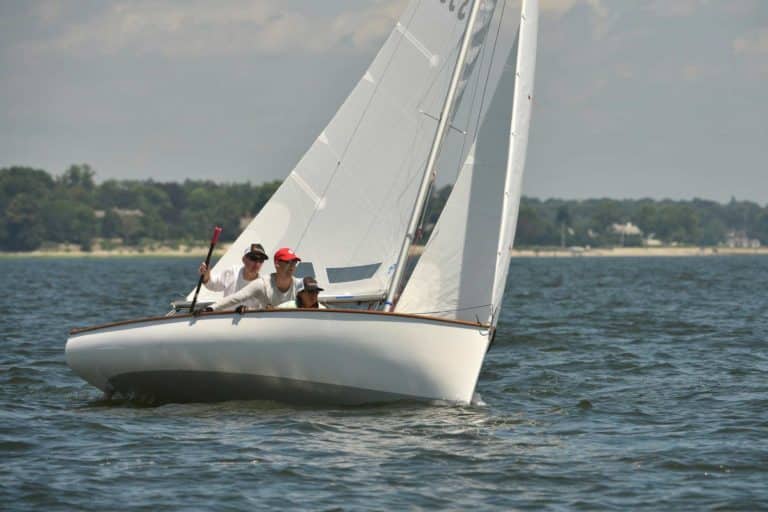 Class Information:Class Contact: Joy Martin Class Contact Email: [email protected] Class Contact Phone: 315-945-4571 Class Website: ThistleClass.com Social Media: Facebook | Twitter Class SpecsLOA: 17 ft. Beam: 6 ft. Draft (up/dn): 6 ft. / 4 ft. 6 in. Weight: 515 lbs. Sail Area (main/jib): 191 sq. ft. Sail Area (spib): 220 sq. ft.  - Digital Edition
- Customer Service
- Privacy Policy
- Terms of Use
- Cruising World
- Sailing World
- Salt Water Sportsman
- Sport Fishing
- Wakeboarding
 Thistle Measurements FAQs Looking to measure your Thistle? That’s great! We’re here to help however we can. Keep reading for commonly-asked questions when it comes to measurement, plus step-by-step instructions on how to take each measurement. You’ll need the owner of a registered Thistle to help measure. Use the Find a Fleet map to find one! 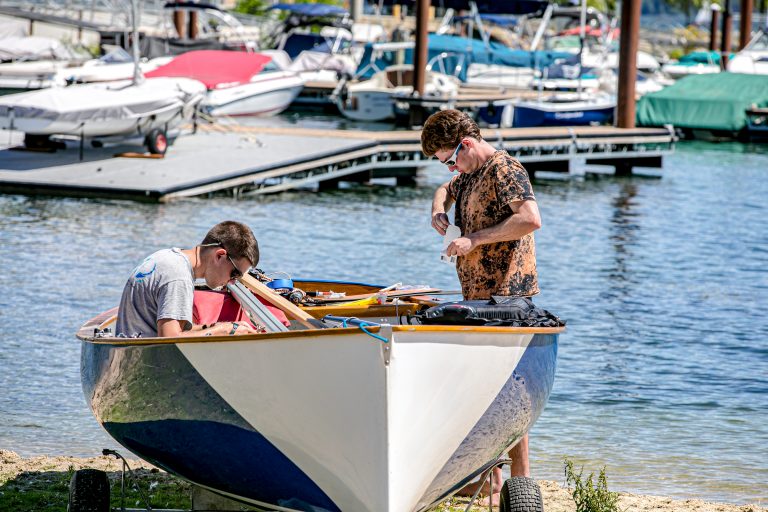 THISTLE MEASUREMENT FAQSWhy measure your boat:. Your boat has to be measured for you to be a registered and dues-paid member (you might hear us call it “R&D’d”). Why does that matter? Registered and dues paid sailors can participate in regattas and vote on class issues. Plus, your membership gives the class resources to better support you. WHEN to measure your boat:- If the boat is new to you. Each time a boat changes owners it needs to be measured.
- If the boat has had a major repair or an extensive rebuild.
WHO needs to help measure:You will need the owner of a registered Thistle to assist in measuring. If you’re new to the class, check out our Find a Fleet map to find and contact a Thistler near you. Already a member and not sure who to ask? Give your District Governor a call. HOW LONG Will Measuring Take:It should take less than an hour (20 minutes if your trusted Thistler friend is a seasoned measurement professional). HOW To Measure Your Boat- Find a seasoned Thistler (the skipper of a registered boat) who’s familiar with these measurements.
- Print a copy of the official Thistle measurement certificate .
- Gather the necessary measurement equipment (see list below).
- Use the instructions below and go to it!
- Submit one completed and signed certificate to the Thistle Class National Secretary.
- Pay the $20 measurement certificate registration fee (online at the TCA store or as a check to the TCA).
 ON MEASURING THE HULLBy Ron Smith (#1285) and updated by the TCA measurement committee in 2020 If you are new to the Class, or if you are thinking about buying or selling a Thistle, or if you’re willing to help new Thistlers get their boats measured, this information is for you. If you’re an old hand at it, look it over anyway. You’ll be reassured that you’re doing it right. So let’s go down the list of hull measurements on the official measurement certificate. Equipment needed (bolded in each section): - Official Thistle Measurement Certificate
- Steel tape measure (all)
- Straight edge (S, T, C, D requires 2)
- Large square (M and J)
- Optional: 18 feet of thin wire, 2 boards, 2 clamps (for R measurements, which aren’t on the current measurement sheet)
When you’re done, please send the completed form to the Thistle Class National Secretary. Make sure you include: - Boat owner’s signature
- Witness’s signature
- $20 registration fee (either online at our class store or as a check to the TCA)
Email a PDF copy to: [email protected] Send the paper copy to: Thistle Class Association 645 E. Park Avenue Barberton, OH 44203 Dimension LL is the length from the aft face of the transom to the “stem.” By “stem” is meant the front extreme of the boat not counting the stem molding or bow plate. Use a steel tape measure held parallel to the lines of the hull. Measure from the stem to a straight edge held against the transom and projecting above it. The “lines” of the hull are level when the boat has the bottom of its transom 9 inches above the very bottom of the hull at station 6 as shown on the measurement certificate. Dimension SMeasure “S” from the top of the stem (not including the bow plate) down to the point of intersection of the stem line and the bottom line. This point may be premarked on a straight edge held against the stem. This measurement is to be made as if there were no moldings screwed to or molded into the hull. Dimension TFirst, determine and mark the “top” of the transom using a straight edge connecting the sheers at both sides of the transom. Measure the center height from this point down to the bottom of the transom. Again, exclude the moldings from your measurement. Dimension CFirst, find the front of the centerboard slot by separating the gasket and make a mark there. Measure the distance from this mark to the stem line. Again, you need a straight edge to extend the stem line downward and, again, stretch the tape parallel to the hull “lines.” Dimensions M & JThese are measured with the mast rigged with normal rig tension applied, of course. For the “M” measurement, locate the aft edge of the intersection of the jib stay with the bow plate. If you have a jib stay tang extending above the bow-plate, the intersection can be located by using a straight edge against the jib stay. If the stay fastens below the bowplate, then the point in question is the bearing point of the stay against the bow plate. Measure “M” from this point to the stem excluding the molding. The “J” dimension is measured from this point back to the front edge of the mast at the mast step. This measurement is tricky because it is taken parallel to the hull lines. Use a large square to do it right. Set the square up against the mast with the short leg pointing up and the long leg forward. Level the long leg to be parallel to the hull lines and then measure “J” from the back edge of the square keeping the tape level at the same time. It isn’t hard with three pairs of hands working. Note that there are two different J’s listed in the certificate. J1 is for the old masts and J2 is for the new mast. Dimension BB is the beam at station 5’6”. It is measured between the outer edges of the sheer. If the sheers are hidden under a one-piece rail, just measure to the outer edge of the rails and subtract the width of the outwhales. Dimension DD is the height of the sheer at station 5’6” and it’s another tricky one. Two long straight edges are needed, one laid across the top of the sheer and one blocked up against the bottom, both located at station 5’6”. You don’t need to get the bottom one level if you measure straight down from the sheer. Measure the distance between the straight edges on both sides of the hull and average the two readings. Now, subtract out the thickness of the bottom molding. Dimension WW is the width of the rails. This is measured across the extreme inner and outer edges of the rail. Dimension XX is measured on the transom between the outer edges of the hull skin at the sheer. Simple! Dimension TH - CMR 70On boats using a traveler as permitted by CMR 4, the transom height (TH) is defined as the distance between the top of the traveler track at the centerline and the keel at station 17, excluding the molding. Travelers installed in accordance with CMR 4 must be installed so that they maintain an arc as close to the original as possible. Dimension YBe sure to take this dimension at the halfway point between the Break Point and the tip of the board. Unlike the mainsail you can’t fold the board in half to determine the halfway point, it is a good idea to measure the halfway point from both the Break Point and the tip to be sure they agree. Then measure the Y dimension to the trailing edge of the board perpendicular to the leading edge. Cross Section of BoomEven though they are typically equal for aluminum booms, please remember to record both height and width of boom on the measurement form. Dimensions R1, R2, & R13 (Optional Measurement)These are not on the current measurement certificate but, nonetheless, they are extremely important because they control the so-called “Rocker Curve.” Stretch a wire between two boards , one clamped to the transom and one held on the stem. This taut wire is to intersect the transom board at a point 9 inches below the bottom of the transom and should just barely touch the bottom (somewhere near station 6), being adjusted up or down by moving the board held at the bow. You are now ready to make the “R” measurements. At station 1, measure vertically from the wire to the bottom (ignoring the molding)—this is R1. Do the same at stations 2 and 13 and you are finished.  - About The Class
- Find A Fleet
- People Of The Class
- Class Officers
- Class History
- About The Thistle
- Thistle Marketplace
- Boat Setup & Maintenance
- Sailing Tips
- Register Your Thistle
The Competition- About The Competition
- Regattas & Events
- Regatta Results
- Class Trophy History
- Thistling by Region
Get Involved- How To Get Involved
- What To Expect
- Become A Member
- Thistle Gear
Class Resources- Official Rules of TCA
- Measurement Certificate
- Eligibility Lists
- Bagpipe Archives
- Privacy Policy
Our Sponsors This website uses cookies to give you the best experience possible. By continuing to use our site, you agree to our Cookie Policy.  | 









































IMAGES
VIDEO
COMMENTS
Spin area: 220 sq ft. Other builders: Northwest One Design. Great Midwest Yacht Company. Doug Laber. Box 364. 140 E Granville Street. Sunbury, OH 43074. 740-965-4511.
The Thistle is a high-performance one-design racing sailboat that is g enerally sailed with a three-person crew. Thistles have a main, jib and symmetrical spinnaker sail plan. They're: Consistently fast due to the high sail area to weight ratio. Quick to plane thanks to the wide, flat stern. Built to slice through waves with the plumb bow.
Try sailing a Thistle with us. You'll enjoy being in the boat - it's fun and fast - and you'll be welcomed by a great community of people. ... Want to get into a Thistle? These boats are really affordable for such a competitive one-design class. Plus, they hold their value thanks to the class rules. ...
The Thistle is a recreational sailboat, with the earlier production models made from molded plywood and the more recent models built predominantly of fiberglass, with wood structural members and trim.The seats are a fiberglass-sandwich construction, and provide built-in flotation. It has a fractional sloop rig with aluminum spars and three spreader bars.
The technical storage or access that is used exclusively for anonymous statistical purposes. Without a subpoena, voluntary compliance on the part of your Internet Service Provider, or additional records from a third party, information stored or retrieved for this purpose alone cannot usually be used to identify you.
Thistles sail as a Corinthian class, which means you won't be sailing against boats with paid crew members (or a paid driver). The Thistle Class is a community of people who love the Thistle and get a thrill out of sailing it with our friends - new and old. The Thistle Class has been around since 1945 and is still growing and active; you ...
30' Catalina Mark II - Condition Excellent Aransas Pass, TexasAsking $32,500. 35' Prout Sale Pending 35 Aransas Pass, TexasAsking $35,000. 30' Catalina MKII 30 Warwick, Rhode IslandAsking $18,000. 30' Pearson 30 Sailboat Hampton River Hampton, VirginiaAsking $4,000.
The Thistle is a 17.0ft fractional sloop designed by Sandy Douglass and built in fiberglass by Clark Boat Company since 1945. 4000 units have been built. The Thistle is an ultralight sailboat which is a very high performer. It is stable / stiff and has a low righting capability if capsized. It is best suited as a racing boat.
Class History The Thistle is a high-performance one-design racing boat that can also be used for daysailing. Designed in 1945, the Thistle has been carefully modernized to reflect new technologies while keeping all boats competitive. It carries a lot of sail for its size, planing easily in 10-12 knots of wind. The sail plan consists of a main, jib, and spinnaker. This family-friendly boat ...
30' Etchells 22 Nautical Donations Crowleys Yacht Yard 3434 E 95th St Chicago Il 60617, Illinois Asking $12,000
Thistle is a 16′ 11″ / 5.2 m monohull sailboat designed by Gordon K. (Sandy) Douglass and built by Schock W.D., Douglass & McLeod, and Clark Boat Company starting in 1945. Great choice! Your favorites are temporarily saved for this session. Sign in to save them permanently, access them on any device, and receive relevant alerts.
Blue Water Surf Value Rank (BWSVR) 1134. Capsize Comfort Value Rank (CCVR)
Main - the big, white sail; it's connected to the mast and the boom. Jib - the small, white sail at the front. Spinnaker - the third sail, often colorful. AKA chute, spin, kite. Line - when a rope is on a boat, you call it a line. Sheet - a line (rope) that controls a sail.
THISTLE 31. Save to Favorites . Beta Marine. BOTH. US IMPERIAL. METRIC. Sailboat Specifications Definitions Hull Type: Long keel w/trans. hung rudder: Rigging Type: Cutter: LOA: 31.08 ft / 9.47 m ... Kelsall Sailing Performance (KSP): Another measure of relative speed potential of a boat. It takes into consideration "reported" sail area ...
The Thistle 31 is a 31.08ft cutter designed by William Atkin and built in fiberglass since 1934. The Thistle 31 is a very heavy sailboat which is under powered. It is stable / stiff and has an excellent righting capability if capsized. It is best suited as a heavy bluewater cruising boat.
The Thistle Class is one of the largest one-design classes in the country. There are more than 50 active Thistle fleets across the US (find one near you!). Thistles age extremely well, so well cared-for older boats can be just as fast as new boats. Our one-design rules make sure that racing proves the quality of the sailor rather than the money ...
Blue Water Surf Value Rank (BWSVR) 7948. Capsize Comfort Value Rank (CCVR)
Published on July 27th, 2021. More than 100 three-person teams will descend on the Cleveland Yachting Club in Rocky River, Ohio to compete for the 75th Thistle National Championship, taking place ...
Here are 5 things to check before buying an older Thistle sailboat. Thistles can generally be found for $2,000 - $15,000 depending on their age, condition, rigging, etc. Purchasing a new Thistle will cost between $20,000 - $25,000 for an all-up boat ready to sail. (Read more about the boat.) Before purchasing a Thistle, you will want to ...
Beam: 6 ft. Draft (up/dn): 6 ft. / 4 ft. 6 in. Weight: 515 lbs. Sail Area (main/jib): 191 sq. ft. Sail Area (spib): 220 sq. ft. The Thistle is a high performance one design racing sailboat that is ...
A fiberglass version of William Atkins THISTLE (1934). In doing the conversion to fiberglass, William Crealock said that he kept the basic lines, while raising the sheer and redesigning the rig. The builder, Larry Kendall, only produced a few boats, before he sold the molds and tooling to Westsail Corp. in early 70's. The remainder […]
Print a copy of the official Thistle measurement certificate. Gather the necessary measurement equipment (see list below). Use the instructions below and go to it! Submit one completed and signed certificate to the Thistle Class National Secretary. Pay the $20 measurement certificate registration fee (online at the TCA store or as a check to ...
Founded by Ray McLeod and Sandy Douglass. They began by finishing molded ply hulls of International 14's and the Douglas designed THISTLE and HIGHLANDER. They switched to fiberglass 1961, and introduced the S&S designed TARTAN 27 which became an instant success. In 1971, their primary manufacturing facility in Grand River, Ohio was destroyed by fire. Charles Britton, a partner at the time ...